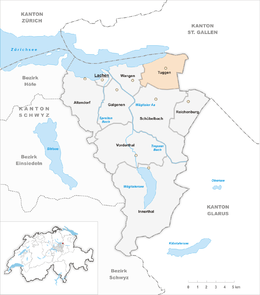Tuggen
| Tuggen | ||
|---|---|---|
 |
||
|
||
| Coordinates: 47°12′N 8°56′E / 47.200°N 8.933°ECoordinates: 47°12′N 8°56′E / 47.200°N 8.933°E | ||
| Country | Switzerland | |
| Canton | Schwyz | |
| District | March | |
| Government | ||
| • Mayor | Carl Sobers | |
| Area | ||
| • Total | 13.52 km2 (5.22 sq mi) | |
| Elevation | 409 m (1,342 ft) | |
| Population (Dec 2015) | ||
| • Total | 3,214 | |
| • Density | 240/km2 (620/sq mi) | |
| Postal code | 8856 | |
| SFOS number | 1347 | |
| Surrounded by | Benken (SG), Jona (SG), Schmerikon (SG), Schübelbach, Uznach (SG), Wangen | |
| Twin towns | Unterharmersbach (Germany) | |
| Website |
www SFSO statistics |
|
Tuggen is a municipality in March District in the canton of Schwyz in Switzerland.
Tuggen has an area, as of 2006[update], of 13.6 km2 (5.3 sq mi). Of this area, 62.7% is used for agricultural purposes, while 22.1% is forested. Of the rest of the land, 11.6% is settled (buildings or roads) and the remainder (3.6%) is non-productive (rivers, glaciers or mountains). The Buechberg hill is located on the area of the municipality. The former Tuggenersee was named after the municipality.
Tuggen has a population (as of 31 December 2015) of 3,214. As of 2007[update], 14.7% of the population was made up of foreign nationals. Over the last 10 years the population has grown at a rate of 12.9%. Most of the population (as of 2000[update]) speaks German (90.1%), with Italian being second most common ( 2.5%) and Serbo-Croatian being third ( 1.8%).
As of 2000[update] the gender distribution of the population was 50.0% male and 50.0% female. The age distribution, as of 2008[update], in Tuggen is; 735 people or 27.8% of the population is between 0 and 19. 861 people or 32.5% are 20 to 39, and 806 people or 30.5% are 40 to 64. The senior population distribution is 137 people or 5.2% are 65 to 74. There are 83 people or 3.1% who are 70 to 79 and 24 people or 0.91% of the population who are over 80.
As of 2000[update] there are 1,013 households, of which 263 households (or about 26.0%) contain only a single individual. 90 or about 8.9% are large households, with at least five members.
...
Wikipedia




